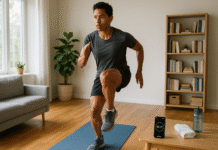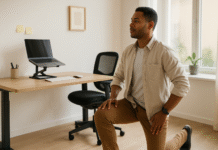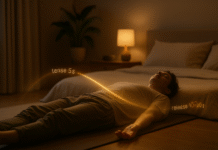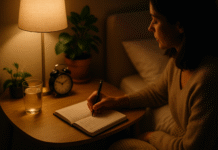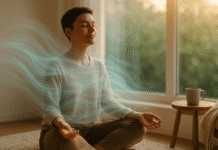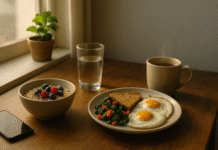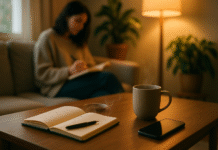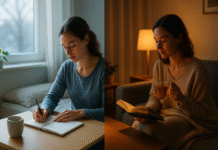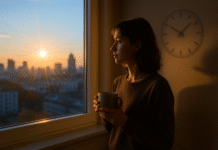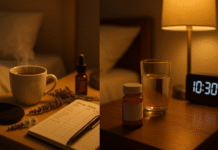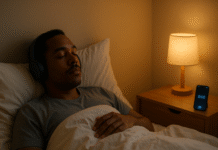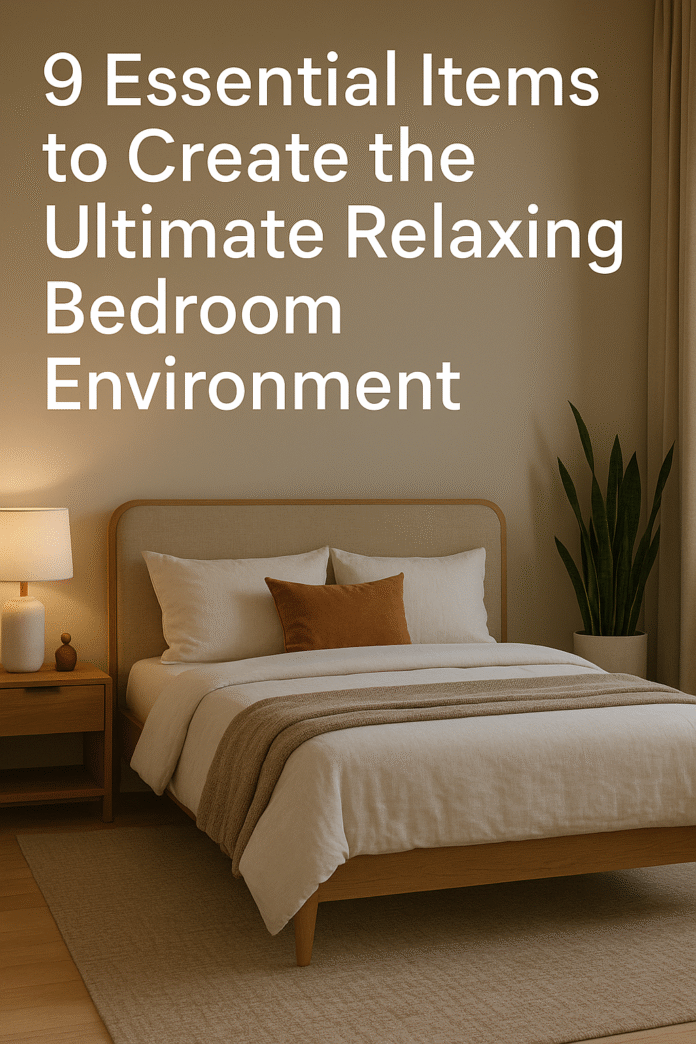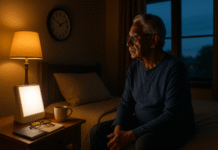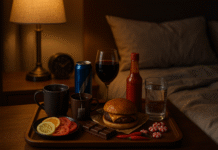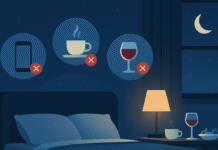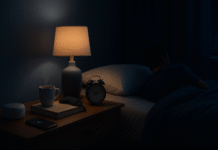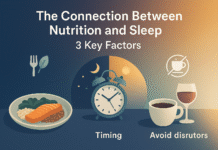Making your bedroom feel like a sanctuary isn’t just a design problem; it’s also a fantastic method to obtain better sleep, less stress, and better health in general. A tranquil bedroom makes it easier to rest, refuel, and think effectively. It makes the place where you spend nearly a third of your life a place of comfort and caring. This post discusses a lot about nine crucial items that can help you relax, sleep better, and make your home a more pleasant environment. It takes ideas from interior design, ergonomics, and environmental psychology.
1. A good mattress and a strong base
The mattress is the most crucial component in a bedroom that helps you relax. Studies demonstrate that a mattress that is comfortable and supportive has a direct effect on how well you sleep and how well your spine is aligned.
Why It Matters
If your mattress doesn’t support you effectively, you can have back pain, problems sleeping, and more cortisol in your body. To maintain your mattress clean and supportive, the National Sleep Foundation suggests you should change it every 7 to 10 years.
Picking the Right Mattress
- Material: Memory foam shapes to your body and eases pressure areas. Innerspring models, on the other hand, give you superior airflow and support. The best thing about hybrid mattresses is that they are the best of both worlds.
- Firmness: Most people who sleep on their sides like a firmness level of 3 to 5 on a 10-point scale, whereas most people who sleep on their backs or stomachs like a level of 6 to 8.
- Certifications: Look for the CertiPUR‑US® mark, which signifies low chemical emissions, or the OEKO‑TEX® Standard 100 label.
The bed frame and foundation
A sturdy bed frame with slats or a firm platform support stops the mattress from sagging and makes it endure longer. Adjustable bases that let you raise your head or legs can make things even more pleasant. This can help with problems like acid reflux or poor circulation.
2. Bedding that isn’t overly heavy and enables air flow through it
The materials you use for your bedding are particularly important for thermoregulation, which is a critical aspect of attaining deep, restorative sleep. The best mattress should be the proper weight, let air circulate through it, and soak up water.
Sheets
- Egyptian or Pima long-staple cotton, linen, or Tencel™ lyocell are all soft, robust, and let air flow through them.
- Weaving: Percale (crisp and chilly) and sateen (silky and warm) both influence how the cloth feels and how air passes through it.
Comforter or Duvet
- Fill Power: Down comforters with a fill power of 600 to 700 keep you warm and fluffy without being overly weighty. People who are allergic should use synthetic fillings that are similar to down or natural wool blends.
- Choose a cover material with more than 300 threads so that air may pass through it without getting too hot.
Thick blankets
- A blanket that weighs 10% to 12% of your body weight will help you sleep better and feel less stressed by placing a lot of pressure on you.
- Make sure the fabric can breathe, like cotton or bamboo, so it doesn’t get too hot.
3. Can be altered and made darker
Light has a huge effect on the circadian cycle. Harsh, blue-rich light at night slows down the creation of melatonin, which makes it difficult to fall asleep.
Lighting in Layers
- Ambient: Warm lights (2700–3000K) on the ceiling that are soft.
- Task: Reading lamps that can be moved and provide a focused beam so you can read at night without lighting up the whole room.
- Accent: String lights, LED strips behind headboards, or floor lamps that give off a soothing light.
Smart controllers
You can use applications and smart bulbs, such as Philips Hue, to make “sunset” lighting scenarios that go darker and change to warmer colors two hours before you go to bed.
How to Fix Power Outages
To avoid outside light pollution from sneaking in, use dimmable lights inside and blackout drapes or shades. This is highly significant for city dwellers.
4. Better sound
Noise pollution makes it hard for a lot of individuals to sleep. It can wake you up and make your stress hormones go up. It is vital to lower the noise level in the region.
How to Make Soundproof
- Soft furnishings like heavy curtains, upholstered headboards, and area rugs can all help keep sounds from outside out.
- Double-glazed windows and window inserts are two forms of window coverings that can help keep noise from the street and traffic out.
- Sealing: Adding door sweeps and weatherstripping to doors makes the passageways quieter.
There are devices and apps for smartphones that play white noise, pink noise, or quiet natural sounds all the time. These sounds can help filter out disturbances that appear from time to time, making it easier to fall asleep.
5. Checking the air quality and temperature
The ideal temperature for sleeping is between 60 and 67 degrees Fahrenheit (15 and 19 degrees Celsius). It is easier to sleep when the air is pure and devoid of allergens and contaminants.
Taking care of the weather
- Thermostat: Smart thermostats, such as Nest, can adjust the temperature at night.
- Ceiling fans: They move the air around without creating a lot of noise.
Cleaning the air
- HEPA filters get rid of more than 99.97% of particles that are 0.3 microns or larger, which is helpful for persons with allergies.
- When you place new furniture or paint in your house, activated carbon pulls up scents and VOCs.
Plants in the House
There isn’t a lot of study on how plants can clean the air, but the snake plant (Sansevieria) and the peace lily (Spathiphyllum) are two examples of plants that help keep the humidity in check and look good.
6. Furniture that is both stylish and comfy
The way furniture is placed and how it fits your body can change how comfortable, helpful, and good for your mind it is.
Nightstands
The height should be the same as the top of the mattress so that you can easily get to it. Add drawers or shelves to cut down on clutter.
Place to sit
A little armchair or window bench is a fantastic location to relax outside of bed. You can read or think there.
Minimalist closet and storage
A untidy place can make you feel anxious. Use drawers under the bed, built-in closets with organizers, and shelves on the wall to keep surfaces free.
The Psychology of Color
People feel more at ease when they see soft, muted colors like sage green, dusty blue, and warm beige. These colors don’t overstimulate them. Decorations or accent walls can add character to a room without going overboard.
7. Using aromatherapy and controlling the humidity
Scents can change the way your brain works, which can help you relax and feel less anxious.
Essential oil diffusers
Researchers have shown that lavender can help people relax and have a better night’s sleep. Chamomile and bergamot can help you calm down and slow your heart rate.
Pillow and linen sprays that smell good
Mist your pillowcases or mattress pads with diluted essential oils to make them smell lovely and soft without being too overpowering.
Things that soak up water
When the humidity is between 40% and 60%, it keeps dry air from hurting your skin and lungs, which helps you sleep better and feel better.
8. Putting together personalized technology
If you don’t use electronics the proper way, they can hinder you from sleeping. But if you do, they can make things easier and more pleasant.
Smart Hub for the Home
With only a few easy commands, Alexa and Google Home can control lights, thermostats, and play peaceful music.
Charging without cables and keeping cords tidy
Devices stay charged and out of sight with built-in charging stations or hidden docks. This keeps your bed clean and stops you from wanting blue light.
Places without screens
Set a time for devices to be switched off, or put a shelf outside of the main sleeping area where phones can charge overnight. This will help you spend less time in front of a screen before you go to sleep.
9. Personal touches and decorations that make you feel good
Your bedroom should be a peaceful haven that shows off your personality.
Art and stuff to put on the walls
Choose pieces with soothing images, such as nature sceneries, abstract art in soft colors, or photographs that make you smile.
Layers and Textiles
Putting rugs, throw cushions, and blankets on top of each other is a terrific way to make a space feel more warm and deep. When you choose textures like velvet, knit, or imitation fur, be careful not to gain too much sensory information.
Show of Mindfulness
Put things on the table that help you stay present, such as a little fountain, a collection of your favorite books, or a specific space to write in your diary and think.
FAQs
1. How often do I need to get a new mattress?
Most mattresses last from seven to ten years. You should obtain a new mattress sooner if your current one is sagging, aching, or making you feel stiff in the morning.
2. Is it safe for everyone to sleep with blankets that weigh a lot?
Most adults and toddlers over the age of 2 can use weighted blankets without any difficulties. But if you have respiratory problems, circulation problems, or sensory impairments, you should see a doctor first.
3. Does the light truly change how well I sleep?
Yes. At night, blue light hinders the body from generating melatonin, which makes it difficult to fall asleep. It’s important for your body’s natural circadian rhythms to have warm lighting that you may turn down.
4. Do plants indoors truly help you sleep better?
Snake plants and peace lilies don’t do much to clear the air, but they can help keep the humidity in check and make the room look serene.
5. What is the best temperature for a bedroom?
It is ideal to sleep when the temperature is between 15 and 19 degrees Celsius (60 and 67 degrees Fahrenheit). When you sleep, your body naturally controls its temperature better when it’s cooler.
6. What are some simple strategies to make less noise?
Heavy drapes, area rugs, upholstered furniture, and door sweeps can help block and soak up noise without costing a lot of money.
7. Is there scientific proof that aromatherapy works?
Clinical studies have shown that lavender oil can help people sleep better by decreasing anxiety and making them sleep more deeply.
8. Should you not bring technology into the bedroom?
Instead of a full ban, build up bedtime routines that don’t involve screens by charging devices outside of the sleep area and employing smart controls for crucial chores.
References
- Lee, A., & Cheng, C. (2018). “Lavender Oil Inhalation Affects EEG Activity and Mood States.” Journal of the Medical Association of Thailand, 101(9), 1234–1242. https://www.jmatonline.com/index.php/jmat/article/view/2059
- National Sleep Foundation. “How Often Should You Replace a Mattress?” NationalSleepFoundation.org. https://www.sleepfoundation.org/bedding-information/how-often-should-you-replace-your-mattress
- CertiPUR-US®. “CertiPUR-US® Certification Criteria.” https://certipur.us/certification
- Harvard Medical School. “Why Temperature Matters for Sleep.” Health.harvard.edu. https://www.health.harvard.edu/staying-healthy/why-temperature-matters-for-sleep
- American Academy of Sleep Medicine. “The Therapeutic Use of Weighted Blankets.” https://aasm.org/clinical-resources/weighted-blankets
- Mayo Clinic. “Blue Light Has a Dark Side.” MayoClinic.org. https://www.mayoclinic.org/healthy-lifestyle/adult-health/in-depth/blue-light/art-20479111
- Philips Hue. “Circadian Lighting Review.” https://www.philips-hue.com/en-us/what-is-circadian-lighting
- World Health Organization. “Environmental Noise Guidelines for the European Region.” WHO.int. https://www.who.int/publications/i/item/9789289053563
- Sleep Foundation. “Optimal Bedroom Temperature.” SleepFoundation.org. https://www.sleepfoundation.org/bedroom-environment/optimal-bedroom-temperature
- NASA Clean Air Study. “NASA’s Indoor Air Study.” https://ntrs.nasa.gov/citations/19930073077
- Color Psychology. “How Colors Affect Emotions.” ColorPsychology.org. https://www.colorpsychology.org/how-color-affects-your-moods/


